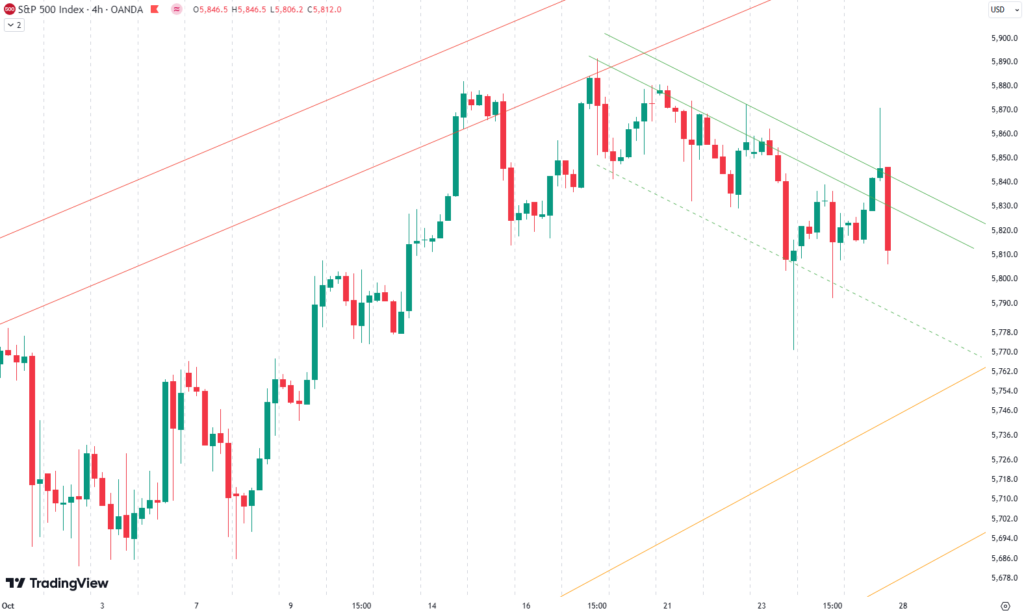Welcome to our weekly S&P 500 newsletter. This week, the S&P 500 experienced a 1.0% gain despite a highly volatile trading pattern. After last week’s signals of an overbought market, a pullback seemed likely, and indeed, the index saw significant shifts throughout the week.
From Monday through Wednesday, the S&P 500 experienced a steady decline, including a sharp mid-week drop. However, the index rebounded strongly leading into Friday, aligning with the green trend lines visible on the 4-hour chart. As the S&P 500 neared the top of a downward trend channel, it encountered resistance, resulting in a swift decline to close out the week. This series of moves hints at the potential for further consolidation, as we await more market signals and monitor upcoming resistance levels.

Our last position, which we placed on August 8th, has been active until September 5th, when we sold it for a gain of 7.7%
Are you wondering when to buy the S&P 500 as an investor? Explore our tailored services and join our growing community of do-it-yourself investors who have successfully navigated the market with our guidance.
Premium Guide
Advanced Investing Signals
$139 / Month
Basic Guide
Basic Investing
Signals
$49 / Month
Simple Guide
Selected
Signals
Free
Congratulations! You’ve discovered your new free financial guide. Simply sign up for our most popular service, our Simple Guide.
Market at Election Crossroads
Since the August low, the S&P 500 has climbed an impressive 14.1%. Observing the daily chart provides a broader view, where this week’s decline, while notable, doesn’t signal an immediate trend reversal. The S&P 500 is coming off a recent overbought region near the upper red trend line, which forms the top boundary of a rising wedge. The index now sits near the middle of this wedge pattern, with the lower boundary marked by a yellow trend line.
Friday’s steep drop might indicate a further pullback in the coming week, potentially pushing the index down toward this yellow trend line. Should the S&P 500 break below this level, it could suggest a deeper correction. However, if support holds, it could reinforce the trend as we move closer to a pivotal event: the U.S. election. Given the market’s current technical setup, the S&P 500 may be in a “make-or-break” position, as election outcomes often influence broader market sentiment. For subscribers it is very important to follow our risk management measures that we provide with all our services to protect against losses in case support zones break

The next few months
The chart shows the typical seasonality for the S&P 500 during an election year, indicating patterns of market behavior around key months. Historically, we see a tendency for market weakness in May, June, and July, followed by a period of strong price gains up to early September. However, this is usually succeeded by a larger correction leading up to the election at the beginning of November. The period from mid-June to the end of July is characterized by some market softness, with only modest upward movement, which aligns with the recent declines we’ve witnessed. As we in October, which is historically a weaker month of the year, we may continue to see this pattern of volatility. Given the historical data, there could be further weakness until the U.S. election on November 5th. However, it’s important to interpret this seasonality with caution, especially this year, as we have already experienced a significant rise in prices. Investors should consider both seasonality trends and our analysis for a balanced view. Proper risk management is essential in navigating these market conditions.

Our Market Dashboard provides a quick overview of the current market conditions and, more importantly, the associated risk. You can view a chart of one of our tools, the Risk Level Indicator, showing predicted risk from 1998 to 2024. If you are interested, you can visit our Dashboard site here.

The world of finance is complex and includes many technical terms. For explanations of these terms, I recommend using the Investopedia dictionary.

Leave a Reply